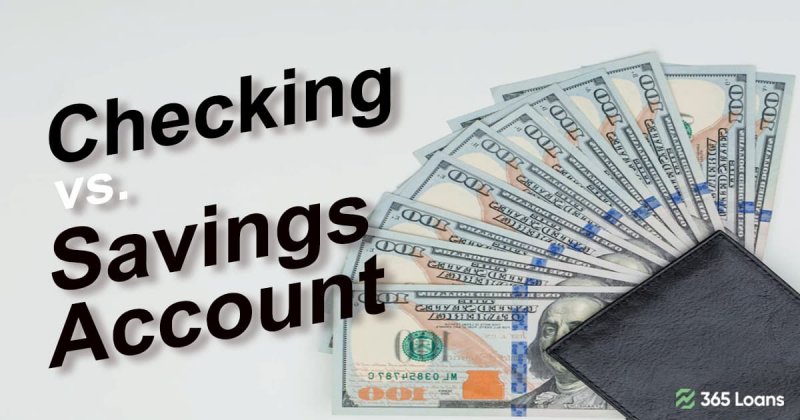You might be considering whether a checking or savings account is better suited to match your needs when it comes to money management. Though they do not operate similarly, both kinds of bank accounts can help with various demands for managing your finances.

What is a Checking Account?
A checking account is a financial institution account that enables debit and credit transactions. For example, these accounts might allow you to write checks in addition to receiving a debit card. Cash withdrawals at a branch or an ATM and debit card transactions, cheques, money orders, ACH transfers, and wire transfers are all examples of withdrawals allowed with the checking account.
Similar to withdrawals, you can also make deposits using a mobile check deposit app, an automated clearing house (ACH) transfer, or a wire transfer in addition to cash, checks, or money orders deposited at a branch or an ATM.
A checking account is a proper choice if you need to use it for daily transactions like:
- Paying bills online or with a check;
- Using a linked debit card to make purchases or ATM withdrawals;
- Electronically transfer funds to a separate bank account.
Checking accounts might or might not pay interest. If the former, then interest is paid on the funds you deposit for as long as they remain in your account. Brick-and-mortar banks, internet banks, credit unions, and other financial institutions can provide these accounts.
What is a Savings Account?
A savings account is a deposit account intended to retain money not planned for daily expenses like paying bills or spending. To increase your emergency fund, save for a vacation, increase your down payment if you intend to purchase a home, or put money aside for home upgrades, for instance, you might open a savings account.
Savings accounts are available from various financial institutions, including traditional banks, online banks, and credit unions, just like checking accounts. In addition, you are more likely to make interest with savings than with checking accounts.
As a reward for depositing and maintaining funds in their savings accounts, banks pay depositors an annual percentage yield (APY). But the APY that savers can get varies. Moreover, it may differ from one bank to another. As of June 2022, the average savings rate in the USA is 0.08 percent.
Due to their decreased overhead and operating expenses, online banks may frequently offer more excellent interest rates to savers. It is not unheard of to discover high-yield online savings accounts from banks and credit unions yielding an APY between 1.90 percent and 2.25 percent. However, rates can vary greatly.
Checking vs. Savings Account: Differences
If you compare checking and savings accounts, you might discover that one is more suitable for your needs than the other, and in other circumstances, you might find that using both will be beneficial.
Keep the following questions in mind when looking around for a checking or savings account.
| Checking Account | Savings Account | Differences Explained | |
|---|---|---|---|
| Does it have a minimum balance requirement? | Depends on the bank. | Yes. | The amount you should hold in your checking account, for example, relies on a few crucial criteria. Therefore, there is no set recommendation. Still, you should at least have that amount in your account if your bank needs it; else, you run the danger of being slapped with service fees that deplete your balance. However, it is wise to always retain one to two months’ worth of spending in your bank account. This makes sure you have adequate money in case of emergency to pay your bills and support your living expenses. With a savings account, you still have to make a certain minimum deposit to open an account. |
| Do you need to meet specific requirements to open the account? | Yes. | Yes. | Before you may open a bank account of any kind, including a checking or savings account, there are a few requirements. This is necessary so that the banking institution can confirm your identification. You will thus require a current piece of government-issued identification, such as a passport or driver’s license or address verification. You must also bring any required deposits if your bank requires them. |
| Does it have limits on withdrawals? | Rarely, if ever. | Mostly, yes. | Withdrawals from checking accounts are practically unrestricted, which is a significant plus. Without incurring any fees from the bank, you might use your card ten times daily for shopping, cash withdrawals, and bill payment. But with your savings account, that could not be the case. Instead, your account provider may impose excess withdrawal fees if you withdraw more than allowed monthly. |
| Which account earns you the most interest? | Little to no interest. | Greater than with checking accounts, but still relatively low. | With checking accounts, you get little to no interest in return for your money in the bank. Most savings accounts, however, have some interest rates despite being relatively low. Some solutions are still available for both cases that will offer you higher returns, which is not all bad. You need to look. Think of accounts with tiers that increase in rate as you make larger deposits. Another choice is a high-yield savings account, which offers more returns for deposits of higher balances, typically $5,000 or more. If that isn’t sufficient, you might choose to open a money market account, which combines the characteristics of a checking and savings account. This kind of account invests in additional automobiles using your funds. |
Which account type should you choose?
Regarding banking, keep in mind the type of access you require. For example, whether you select a checking or savings account, consider the bank’s availability of the branch banking services you might occasionally need, the number of ATM locations, and the online and mobile banking tools you require to manage your money digitally.
Additionally, evaluate if the bank provides unique benefits for creating an account. For example, due to the fierce competition among banks in this context of absurdly low-interest rates, there are occasionally promotions that could enhance the appeal of a checking or savings account.
Compare prices to find the best suits your demands and way of life. For example, if you are strictly after returns, an online savings account is a much better choice, with a rate of approximately 20 times greater than a standard checking account. It’s pretty comparable to the return on a 10-year Treasury Bond that you may receive. However, if you want to be versatile in how you use your account, then keep in mind that some banks reward client loyalty with excellent rates if customers create both a checking and savings account.







